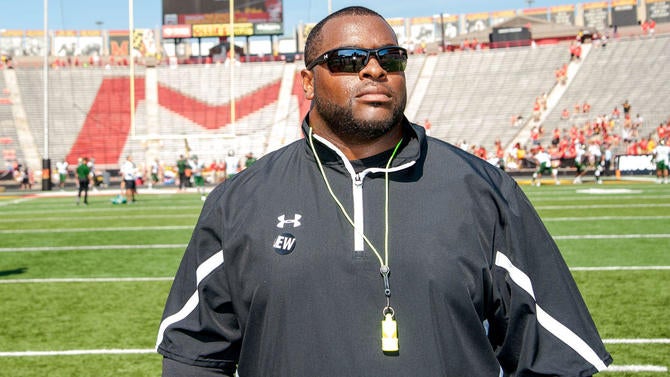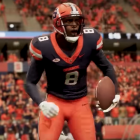When three Oregon football players were hospitalized in January following a strenuous workout, they were being led by a strength coach certified from a track and field coaches association.
For a $245 fee, the U.S. Track and Field and Cross Country Coaches Association (USTFCCCA) offers a 21-hour strength training course to become a certified NCAA strength coach in any sport. By comparison, the widely-used Collegiate Strength and Conditioning Coaches Association (CSCCA) requires 30 times as much training -- a 640-hour certification process.
According to the NCAA, that track certification was all that was needed by Oregon football strength coach Irele Oderinde, who was suspended for one month due to the January workout. But should it be? Four industry experts with more than 100 combined years of experience told CBS Sports they don’t consider Oderinde properly certified to be a football strength coach.
Oregon told CBS Sports that Oderinde and his staff may seek “additional certifications.”
Oderinde is not alone. A CBS Sports investigation found -- in an age when college athlete welfare is paramount – that some strength coaches are not as qualified as they should be in the eyes of some medical professionals and players.
“Are you going to get a 21-hour class to practice law or medicine?” said Jay Hoffman, University of Central Florida sport and exercise science professor. “It’s a four-year degree. For most strength coaches, it’s four years plus a two-year master’s program that provides the [necessary] experience.”
The NCAA requires only a “nationally accredited strength and conditioning certification program” on a coach’s’ resume. However, training has become so specialized that experts say the NCAA rule is both too broad a requirement and not nearly enough of one -- as players continue to die in the offseason.
“They [Oregon] got away with it because none of them [the players] died,” said Hoffman, also chair of UCF’s Education and Human Sciences Department.
Since 2000, 32 NCAA football players have died -- six from traumatic deaths and 26 from non-traumatic deaths. That makes it about 4.5 times more likely a player dies while training for football in the offseason than from a traumatic injury playing football.
In a paper scheduled to be published this month, Oklahoma athletic trainer Scott Anderson wrote that since 2000 more players have died in February conditioning alone than in the previous 16 years of games, in-season practices, preseason practices and spring practices – combined.
With college football’s “killing season” in full swing -- the overwhelming majority of deaths occur in the offseason -- Oregon’s situation raises fundamental questions. What’s the standard to be an NCAA strength and conditioning coach? And are players as safe as they should be?
“We’re killing kids in preparation for the game,” Anderson said. “The game itself is relatively safe.”
Questions about Oregon’s strength coach
The industry’s two main accredited bodies are the National Strength and Conditioning Association (NSCA) and the CSCCA. The overwhelming majority of Power Five head strength coaches have certification from one or the other, yet even those two associations aren’t on the same page.
At Oregon, Oderinde is the only one whose lone certification was approved by a track and field association. Oregon’s nine other strength coaches are certified by the NSCA or CSCAA, according to university documents provided to CBS Sports through an open-records request.
Oderinde was certified by the USTFCCCA on Aug. 15, 2016, while at the University of South Florida, according to his certificate. It’s not clear what -- if any -- certification Oderinde had at USF between Aug. 1, 2015, when the NCAA bylaw requiring national certification went into effect, and Aug. 15, 2016. USF said it’s in the process of determining whether Oderinde was certified during that one-year gap, and if so, by what organization.
Oregon declined to provide a copy of Oderinde’s resume to CBS Sports since it is part of his faculty record. Oregon said faculty records cannot be released without an employee’s written permission, and Oderinde did not grant permission.
“I think a track and field certification would be just fine for a track and field coach,” said Boyd Epley, the man largely credited with being the first paid strength coach with Nebraska back in the 1970s. “But when you’re dealing with athletes that play football, that certification should match up to the needs of that sport.”

Tom Lewis, the USTFCCCA’s director of media, broadcasting and analytics, said the strength training course includes “instruction in the proper application of training and progressions as they relate to student-athlete preparation levels.”
While in compliance with the letter of the NCAA bylaw, Oderinde is among a handful of those coaches who, experts say, are underqualified.
Oderinde was suspended Jan. 17 after three Oregon players were hospitalized after a strenuous workout. One of those players became afflicted with rhabdomylosis, according to his mother.
“Rhabdo” -- how industry experts refer to it -- occurs following overexertion. Muscle fiber breaks down and leaks into the bloodstream. Urine can become discolored, and kidney failure can occur -- or even death.
Oregon was at least the fourth high-profile case of rhabdo since 2013 in any sport at a Power Five school. Head coach Willie Taggart later apologized and visited the three players in the hospital. Oderinde returned to work Feb. 19. Instead of reporting to Taggart, Oderinde now reports to an Oregon director of performance and sports science.
Oderinde’s online bio says he has a bachelor’s degree in recreation administration and a master’s degree in sport management -- neither of which pertain to exercise science or a related field, as the National Athletic Trainers’ Association (NATA) recommended in 2012 to prevent sudden death.
According to the USTFCCCA website, Oderinde’s track and field certification is accredited by the National Council for Accreditation of Coaching Education (NCAC).
“They’re [NCAC] really small and they’re really new,” said Scott Caulfield, NSCA head strength coach. “I don’t know if they understand what they’re trying to credential. They’re not really known in any credentialing context.”
Meanwhile, the NSCA and CSCCA are accredited by the more mainstream National Commission for Certifying Agencies. The 40-year-old NCCA claims to have accredited more than 130 organizations.
Oregon did not grant CBS Sports requests to interview Taggart, Oderinde, the three players who were hospitalized or athletic director Rob Mullens. Instead, Oregon provided a copy of an internal review performed by a faculty athletics representative and a statement.
“Irele Oderinde’s strength training certification from the USTFCCCA meets guidelines set by the NCAA. As has already been reported, Oderinde was suspended for a month without pay and supervision of the football strength and conditioning program was moved to Director of Performance and Sports Science Andrew Murray.
“This move creates a stronger connection with the Marcus Mariota Sports Performance Center and provides appropriate oversight to protect the health and safety of student athletes, which is our top priority. This structure also will provide Oderinde and his staff with opportunities for continued professional development and training, which may include seeking additional certifications.”
Texas assistant head strength and conditioning coach Sandy Abney said Oderinde’s qualifications would not allow him to be hired by the Longhorns. Abney is certification commission chair of the CSCCA.
Anderson said Oderinde’s background, based on what has been discussed in the media, does not meet the standards for NATA. The leading association for athletic trainers has guidelines requiring strength coaches to have an undergraduate degree before taking a certification exam and recommends the degree be related to exercise science.
Before Oderinde was hired, Oregon’s job posting in December 2016 listed minimum qualifications that seemed to fall short of the NCAA bylaw that says a strength coach shall be certified by “a nationally accredited strength and conditioning program.” Oregon’s posting said it preferred -- not required -- a certified strength coach who has a master’s degree. Oregon’s minimum qualifications wanted candidates with a bachelor’s degree, three years in Division I or pro sports, and experience with “diverse populations.”
The standards for strength and conditioning coaches “are sort of where athletic trainers were about 25 or 30 years ago,” said NCAA chief medical officer Brian Hainline, who would not comment specifically about Oregon.
For example, as a condition of a state license for athletic trainers, most states require the passage of the NATA certification exam. Even with that, when an Oklahoma State basketball player died following a workout last summer, it was discovered the certification for the Cowboys’ athletic trainer had lapsed, according to The Oklahoman. Without certification, he could not receive a state license.
Florida State All-American safety Myron Rolle believes college football strength coaches need to be held more accountable.
“I’m a neurosurgeon now,” Rolle said. “Imagine if I walked into a patient’s room and I just took an online class to be certified, and I said, ‘I’m going to do your surgery today.’ That patient would say, ‘Get out of my room.’”
Undoubtedly, there are many good NCAA strength coaches. But the reality is there’s no clear industry standard for how to certify them. That decision is basically left up to the schools.
The NCAA bylaw itself is less than two years old, and it’s watered down, according to some industry experts. The NSCA and CSCCA sent a joint statement to the NCAA in 2015 demanding “higher professional guidelines.”
Frustrated at the lack of response, the two bodies sent the NCAA a joint letter on March 3 that calls on college sports’ governing body to require every strength coach to have a NCCA-accredited strength and conditioning certification. The NCCA is the organization the NSCA and CSCCA use, but it’s not the one that oversaw Oderinde’s certification at Oregon.
The NSCA and CSCCA propose that NCAA strength coaches without a bachelor’s degree be allowed up to four years to obtain an accredited certification. They also suggest that new hires from a specified date must hold an accredited certification.
The letter states that “ambiguity” by universities when interpreting the NCAA’s rule places athletes at risk. “Our organizations firmly believe the NCAA, as the governing body, should provide clarity and guidance on the standards for accredited strength and conditioning certification programs to their member institutions,” the NSCA and CSCCA wrote.
Add in the intense competitiveness from a multi-billion-dollar industry that’s made football training year-round and the recipe is clear for college football’s “dirty little secret,” as Oklahoma’s Anderson describes offseason deaths due to workouts.

There’s no NCAA standard for strength coaches
The avalanche of acronyms involved in this story disguise a core issue: Schools get to decide what “nationally accredited” means when it comes to certification.
Oderinde came to Oregon with Taggart from USF. The strength coach had previous stops at Western Kentucky, West Virginia, Notre Dame and South Carolina.
The course description at the USTFCCCA, where Oderinde was certified, says a minimum of two years of coaching experience is “suggested.” The USTFCCCA promotes that its certification meets all NCAA requirements, though it also notes “institutionally based policies may differ.”
There is broad interpretation and little or no incentive for the NCAA to punish a school that hires an uncertified coach. An NCAA spokesman said a school “could” be investigated for certification violations, but the association’s “preference is to assist institutions to find ways to understand and comply with the legislation.”
There are only nine major-infractions cases in NCAA history that even tangentially mention a strength and conditioning coach. No findings of violations have ever occurred for the 2015 bylaw.
Similarly, there appears to be no strength specialists who have lost their certification from the two largest accrediting agencies for NCAA members. Officials from both the NSCA and CSCCA told CBS Sports they know of no instance when they have revoked a certification due to disciplinary action.
“We haven’t had to pull anyone’s certification,” said CSCCA executive director Chuck Stiggins, a former BYU strength coach. “I want you to know, and I mean this with humility, we are the gold standard for certification. Other organizations have 65,000 to 70,000 certifications. We only have about 840. Those who have our certifications are very skilled.”
Said Caulfield, the NSCA strength coach: “To my immediate knowledge, we have never revoked a certification due to disciplinary action.”
How is it possible that no certifications have been revoked by the NSCA or CSCCA? Hainline, the NCAA’s chief medical officer, danced around that question and said the NSCA and CSCCA must come together to decide how standards will move in the same direction.
“The pressure for there to be a paradigm shift is going to be pretty strong,” he said. “It can’t be the NCAA saying, ‘This is how accreditation and certification has to take place,’ but there is going to be other forces that are essentially going to shine a spotlight on the process.”
Hainline said a large number of sports medical organizations want to develop standards for medical care within an integrated medical team, including strength and conditioning specialists. The culture for evaluating strength coaches must shift from performance-based to medically-based, Hainline said.
“That’s the only way you’re going to be able to achieve peak performance, if it’s in an environment that’s safe,” he explained.
Stiggins stated in a 2015 letter that the NCAA backed off specific recognition of the NSCA and CSCCA because of “legal considerations.”
Consider the differences in some requirements for three associations, among others, that certify NCAA strength coaches:
CSCCA: Bachelor’s degree; 640 hours of training; an internship; pass science-based written and oral exams; current CPR/Automated External Defibrillator/First Aid certification. The CSCCA said it certified, in 2015, 37 percent of full-time Football Bowl Subdivision strength and conditioning coaches in all sports and 32 percent in the Football Championship Subdivision. According to the CSCAA, 71 percent of its 221 candidates in 2016 passed for certification.
The CSCCA board of directors includes what it calls 10 “Master Strength and Conditioning Coaches,” including Ohio State’s Mickey Marotti, Clemson’s Joey Batson and Iowa’s Chris Doyle. Doyle was Iowa’s strength coach when 13 football players were hospitalized in 2011 due to rhabdomyloysis. The school settled for $15,000 with one player who sued for negligence.
Caulfield told CBS Sports, “To become a master, there’s no actual mastery involved. Basically your master is not getting fired. After you’ve been a strength coach for 12 years, you become a master strength coach.”
NSCA: Bachelor’s degree or enrolled as college senior; current CPR/AED certification; pass a two-section exam consisting of scientific foundations and practical/applied science. The NSCA said it doesn’t track how many NCAA strength coaches it certifies. The NSCA reported 35,406 certified professionals, including strength coaches, trainers, physical therapists, athletic trainers and professors.
The NSCA’s reputation has taken a hit lately. In 2013, the NSCA published an article in its Journal of Strength and Conditioning Research that suggested popular exercise company CrossFit poses an injury threat. CrossFit sued and claimed the data used had been discredited, which the NSCA conceded in a 2015 correction. The federal judge in the ongoing case ruled evidence could reasonably support that the NSCA knew the injury data were false but published them anyway to “protect its position in the market” and diminish “the burgeoning popularity of the CrossFit program.”
USTFCCCA (Oderinde’s certification): 21-hour “high level, detailed course” on strength training; undergraduate degree; CPR/AED/First Aid certification; pass 18 online quizzes from home about the 18 course units; pass hypothetical designed training for an athlete.
To pass the course, online quizzes require a 75-percent grade and no more than five “minor” errors in the pass/fail designed training project, according to the three-page course syllabus. “Minor” and “serious” errors are defined in the three-page course syllabus. The USTFCCCA said about 83 percent of applicants pass the course.
It’s not clear how many NCAA strength coaches are certified by the New Orleans-based association, which is a trade organization to develop skills for track and cross country coaches.
Some medical and industry professionals, including Hainline, believe states must start licensing strength and conditioning coaches to provide more accountability. Experts say the lack of standards are particularly troubling since strength coaches spend more time with players than almost anyone else in athletic departments.
In 2015, Tennessee coach Butch Jones said his program did a study showing 86 percent of a player’s time with the program is spent with the strength and conditioning staff.
The strength coach is usually “one of the most consistent people in [players’] lives,” said USC football strength coach Ivan Lewis. “Usually the strength coach is tasked to hold the team accountable as far as being on time, going to class, communication, etc. The strength coach usually has the best vibe of the team because he is around them so much.”
Many football strength coaches are among the highest-paid employees at their university. Several strength coaches make more than FBS head coaches.
Arizona athletic trainer Randy Cohen said he is less concerned about occasional high-profile stories about college athletes suffering from rhabdo than he is seeing bodies break down all year. Cohen said year-round training is not allowing NCAA athletes’ bodies to properly heal and too many players feel pressured to take pain medicine just to get through offseason workouts.
“We see a whole bunch of shoulder and cartilage tears, hip and groin issues, lower back and stress fractures,” said Cohen, past chairman for the NATA college committee. “It doesn’t make the news when the kid’s out with a herniated disc, but a lot of times we’re seeing them pushed past what they can do. That changes the function of that body part for the rest of your life. A lot of us believe these injuries are from workouts without proper rest time and recovery.”
In 2003, the NCAA passed reforms intending to reduce how often football players spend on offseason workouts and to make them safer. This came after a blue-ribbon panel led by former Texas athletic director DeLoss Dodds and former Baylor coach Grant Teaff studied the issue.
Oklahoma’s Anderson said what followed in 2004 for the NCAA was “among the deadliest year for conditioning in any sport or era.” To this day, those 2003 reforms “rank as one of -- if not the greatest -- abject failures of NCAA policy ever,” Anderson said.
As exercise science and technology provide far greater knowledge about workouts, who’s making sure strength coaches know what they’re doing? On too many NCAA campuses, experts say, the answer seems to be no one.
What happened at Oregon’s workout?
At Oregon, Oderinde now reports directly to Murray, the director of performance and sport science, instead of Taggart, the Ducks’ head coach.
While not speaking directly about Oregon, the NCAA’s Hainline indicated the type of higher training Murray has in sport science is needed for strength specialists. Athletic trainers are moving toward a path where they must be a master’s level trainer.
Oderinde replaced Jim Radcliffe, who at Oregon had been one of the most respected football strength coaches in the country. Radcliffe is certified by the CSCCA.
“I’m not sure why they suspended [Oderinde],” said Hoffman, a former NSCA president. “Is he going to get smarter a month from now? Either he’s qualified -- then he shouldn’t be suspended -- or he’s not qualified and he should be fired.”
The workouts at Oregon that resulted in three football players getting hospitalized for several days were “akin to military basic training,” including up to an hour of continuous push-ups and up-downs, The Oregonian reported.
Oregon players had been off for about a month before the workouts. Some Oregon players have said they didn’t view the workouts to be outside the norm of what they traditionally do.
Taggart, who issued an apology shortly after the workouts, denied the workouts were “military style” to CSNNW.com and said the idea was to ease players into offseason conditioning without running or weightlifting. He said dehydration was an issue, coaches did not order players to work past their limitations, and some players pushed themselves too hard.
“These guys were tough guys and wanted to show the coaches,” Taggart said, according to CSNNW.com. “That’s probably what was part of the problem. They didn’t want to be the guy that quit. There were other guys that quit and they didn’t want to so they probably pushed themselves to a limit that they shouldn’t have.”
Hoffman said Taggart’s comment blaming dehydration is “one of the most ridiculous statements I’ve ever seen.” Hoffman added Taggart should, “thank God that one of these players wasn’t an African-American with sickle cell trait or there wasn’t heat to exacerbate the situation.”
Until 2010, the NCAA didn’t require testing for sickle cell trait. The condition can cause death when athletes aren’t properly acclimated to strenuous conditioning.
“It’s absurd a coach can make a situation like that and make excuses,” Hoffman said.
Oregon president Michael Schill told The Oregonian he was “very upset” players had to be hospitalized after the workout. “Whether it was through our exercise programs, or the students were too afraid to be called weenies that they didn’t stop when they should’ve stopped, I don’t care,” Schill said. “The job of our coaches is to look out for their well-being.”
The Oregon workout raises a fundamental question that’s rarely asked out loud in college sports: What is the real purpose of a strength and conditioning coach?
To medical professionals, it’s to safely shape a person’s physiology. To many head coaches, it’s also to shape mental toughness to win football games many months later.
How a head coach picks a strength coach
Boyd Epley is considered the father of modern strength training. He basically invented the position at Nebraska in 1970s and later founded the NSCA in 1978.
Today, Epley is Nebraska’s assistant athletic director for strength and conditioning and sees a profession still refining itself. He said some workouts are improperly designed for the sake of extra discipline and mental toughness.
“While there are elements of this in any form of coaching and training, many attempts to do so fall woefully short of, or even contrary to, sound physical training methods, placing student-athletes in dangerous situations,” Epley said.
“Because the strength coach currently often answers directly to the sport coach, there is pressure on the strength and conditioning coach to carry out whatever type of training, discipline or even punishment the sport coach desires.”
Epley said most strength coaches are hired through the normal procedures by the human resources department on campus. The job is posted. Candidates are vetted. Basic requirements must be met. But in high-profile sports like football, Epley said exceptions get made and the strength coach is hired like an offensive or defensive coordinator.
“The head coach wants a certain person, so that is who is picked -- qualified or not,” Epley said. “If that strength and conditioning coach does not hold certification of an appropriately accredited body, the athletic department can come up with an interpretation of the accreditation criteria of an alternate certification to fit their hiring needs until the NCAA further clarifies and enforces their legislation.”
Anderson credited the NCAA for shifting the onus for certification to the schools. But others are more frustrated. Abney, the Texas assistant head coach, said the NCAA decision was “a huge setback” for the strength coaching profession.
“That’s why I kind of scratch my head with CrossFit,” Abney said of the popular exercise company. “Some of those folks seem to be proud that they get [rhabdo]. I’m like, are you getting that it’s a death penalty to a strength and conditioning coach? If you take athletes to that point, you’re done.”
NCAA bylaws require a strength coach who does weightlifting or conditioning to be certified in CPR and first aid. Also, a sports medicine professional must be present at workouts with “the unchallengeable authority to cancel or modify the workout for health and safety reasons.”
Ohio State has gone through a situation similar to Oregon’s twice since 2013. Six Ohio State women’s lacrosse players were hospitalized with rhabdo. At least one member of the women’s track team was treated for rhabdo in 2014. How does a workout reach the point where athletes get hospitalized?
Ohio State athletic director Gene Smith based his school’s situations on “poor communication.”
“If you’re the strength coach and you work the lower body and then the coach the next day is working on the lower body, that’s the stress point,” he said.
Anderson is like a lot of his peers. He’s had enough.
“We just have to somehow get some traction on the issue that keeps happening over and over,” he said. “It’s the same reason [players were injured] at Iowa that [they were] at Oregon. It’s the same issue that’s killing kids as well.”
Players know more than some strength coaches
Former South Carolina star running back Marcus Lattimore came to Washington, D.C. last May intent on making a point. Speaking before the Knight Commission, a group that tries to reform the NCAA, Lattimore laid out a startling statistic: Nine out of 15 former players he informally surveyed sustained injuries in summer workouts -- six in the weight room and three in conditioning.
“Some [strength coaches] are brilliant,” said Lattimore, who played for the Gamecocks from 2010-12. “The ones I had in college were pretty good, but there were some on staff that, embarrassingly enough, I knew more than.”
Rolle, the former Florida State safety from 2006-08, said his head strength coaches at FSU were excellent and provided valuable help, especially by teaching proper nutrition and serving as advocates for players with NFL scouts. But like Lattimore, Rolle questioned the knowledge of some strength coaches lower down the food chain and believed they put players at unnecessary risk.
“I’m not asking you to be a walking, anatomically-correct textbook, but I expect you to at least have some kind of basic understanding of what you’re telling me and how to do it,” Rolle said.
“Sometimes that knowledge gap was seen. I feel like I should not have known more than you if you’re going to be in charge of telling me what to do. If you’re coming in for a job to train a guy like [former Seminoles star] Lawrence Timmons, who’s going to be a first-round pick, and you’re not busting it to do the work and teach us, that’s lack of interest. That’s being inept.”
Unlike in pro sports, college athletes are not legally allowed to unionize. According to a source, the Major League Baseball Players Association has collectively bargained strength training NSCA certification into their deals. The NBA strength and conditioning coaches association partnered with the NSCA in 2015.
For the NCAA, all health issues -- such as whether to set standards for strength coaches -- are intertwined with liability. If enforceable standards are set, you break it, you own it.
“The NCAA has to protect itself a little bit, too,” said Cohen, Arizona’s athletic trainer. “If you set the standards, are you opening yourself up to more litigation when bad things happen and the standard wasn’t enforced appropriately? Right now, the NCAA isn’t losing lawsuits [related to strength coaches], and until they lose a lawsuit, they’re not going to force stuff.”
Hainline said he thinks recent NCAA bylaws giving medical personnel unchallenged authority to care for players will eventually lead to enforceable NCAA medical rules. It’s not clear if or when that will happen.
Instead, universities are the defendants for their own actions. In 2016, the University of California settled for $4.75 million over the death of football player Ted Agu, who had the sickle cell trait and died after a strenuous offseason workout in 2014. Cal strength coach Robert Jackson was also present for the workout years earlier preceding the death of UCF football player Ereck Plancher, who tested positive for sickle cell trait.
The Iowa 2011 case with 13 hospitalized players due to rhabdo resulted in a single $15,000 settlement. The workout in question was only held about once every three years as a test of physical stamina, mental toughness and to see who “wanted to be on the team,” according to an investigative committee report commissioned by Iowa.
Iowa essentially determined the exercises themselves were to blame and no staffer was disciplined. Doyle, Iowa’s strength coach, was named the school’s “most valuable coach of the year” three months after the hospitalizations. He made $625,204 last year as the nation’s highest-paid strength coach, according to USA Today.
Anderson, Oklahoma’s athletic trainer, wrote in the Journal of Athletic Training that 10 of the 13 hospitalized Iowa players had creatine kinase levels during workouts about 120 times higher than 32 Iowa players tested in subsequent August practices. An elevated level of creatine kinase is seen in heart attacks or in conditions that produce damage to the skeletal muscles or brain.
“The method is pushing players’ limits in a belief that the only limits are self-imposed by the untough, the undisciplined, and the unaccountable,” Anderson wrote.
There are well-established guidelines for athletic trainers and strength coaches to handle offseason workouts.
“I always tell my coaches, ‘It’s real easy to go hard in someone else’s body. If it’s your body, how do you feel?’” said Mike Barwis, a former Michigan and West Virginia strength coach and now a consultant to the New York Mets.
Cohen said most workouts in college sports aren’t too hard but rather don’t plan for enough rest and recovery built into the process.
Even when reporting lines don’t go through the head coach, Cohen described a “vicious cycle” where some strength coaches or on-field assistants feel they must prove their value to their head coach by showing how hard athletes are working in the offseason. College football programs now treat the sport like a “12-month-a-year job” for players, making them work at a high level all year instead of getting the body to peak at a later date, Cohen said.
Yes, he said, sometimes athletes must be pushed past their comfort level. But he believes the good coaches know the level a player truly can’t achieve.
“When your design of the workout isn’t to make them a better athlete or get in better shape but to make them tougher, that’s when you get problems,” Cohen said. “A lot of the strength coaches are very well trained. The problem is there are certifications that are very good and others that are weekend courses.
“We don’t have a set standard for what a strength coach should be.”
Correction: The original version of this story referred to the CSCCA as the CCSCA.





















